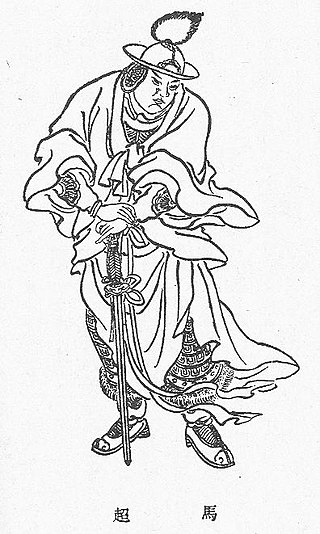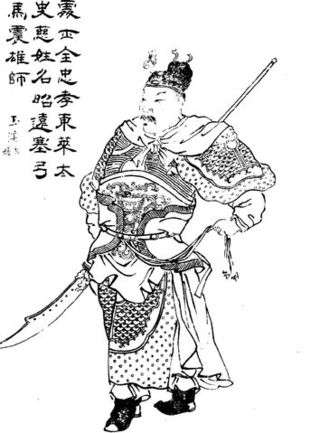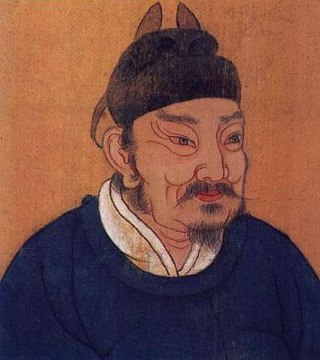
Ma Chao (176–222), courtesy name Mengqi, was a Chinese military general and warlord who lived in the late Eastern Han dynasty and early Three Kingdoms period of China. A descendant of the general Ma Yuan, Ma Chao was the eldest son of Ma Teng, a prominent warlord in Liang Province. In 211, he formed a coalition with Han Sui and other northwestern warlords and revolted against the Han central government, which was led by the warlord Cao Cao. The coalition broke up after losing the Battle of Tong Pass against Cao Cao's forces. Ma Chao initially retreated, but later returned to attack and seize control of Liang Province by killing the provincial inspector Wei Kang and forcing Wei Kang's subordinates to submit to him. About a year after Ma Chao started his uprising, Emperor Xian issued an imperial decree ordering the execution of Ma Chao's family members, who were in Ye city at the time. In the meantime, Wei Kang's subordinates, led by Zhao Ang, Yang Fu and others, rebelled against Ma Chao and forced him out of Liang Province. Ma Chao retreated to Hanzhong Commandery, where he borrowed troops from the warlord Zhang Lu, and returned to attack Liang Province but was ultimately defeated and driven back. Ma Chao took shelter under Zhang Lu for a while until around 214, when he heard that the warlord Liu Bei was fighting for control over Yi Province with Yi Province's governor, Liu Zhang. He defected to Liu Bei's side and assisted Liu Bei in capturing Yi Province from Liu Zhang. Ma Chao had served as a general under Liu Bei since then and participated in the Hanzhong Campaign in 219. He died in 222.

The Yellow Turban Rebellion, alternatively translated as the Yellow Scarves Rebellion, was a peasant revolt during the late Eastern Han dynasty of ancient China. The uprising broke out in c. March 184 CE, during the reign of Emperor Ling. Although the main rebellion was suppressed by 185 CE, it took 21 years for full suppression of resistant areas and emerging rebellions by 205 CE. The weakening of the imperial court and the rising political influence of ultra-autonomous regional military-governors, who helped suppress the rebellion, eventually led to rampant warlord dominance and the resultant Three Kingdoms period.

Taishi Ci (166–206), courtesy name Ziyi, was a Chinese military general who lived during the late Eastern Han dynasty of China. He had served as a minor Han official, before eventually coming to serve warlords Liu Yao, Sun Ce, and Sun Ce's successor Sun Quan.

Guo Wei, also known by his temple name as the Emperor Taizu of Zhou (周太祖), was the founding emperor of the Chinese Later Zhou dynasty during the Five Dynasties and Ten Kingdoms period, reigning from 951 until his death in 954.
Gun, also known as Count of Chong, is a figure in Chinese mythology, sometimes noted as the father of Yu the Great, the founder of the Xia dynasty. Gun was appointed to the task of controlling the Great Flood by Emperor Yao on the advice of the Four Mountains. Gun used dykes to try to stop the flooding but the dykes collapsed, killing many people.
Meng Yi was a Chinese military general and politician. As an official of the Qin dynasty, he served in the court of Qin Shi Huang. He was a younger brother of the general Meng Tian. After Qin Shi Huang's death, Meng Yi and his brother were executed by Qin Er Shi on the urging of Zhao Gao.
Sima Fang (149–219), courtesy name Jiangong or Wenyu, was an official who lived during the Eastern Han dynasty of China. Through his second son Sima Yi, he was an ancestor of the ruling Sima clan of the Jin dynasty (266–420) of China.
This article contains the family trees of members of the Sun clan, who ruled the state of Eastern Wu (229–280), in the Three Kingdoms period (220–280), in China.
This article contains the family trees of members of the Liu clan, who ruled the state of Shu Han (221-263) in the Three Kingdoms period (220-280) in China. They were related to the House of Liu, the imperial clan of the Han dynasty.
This article contains the family trees of members of the Cao clan, who ruled the state of Cao Wei (220–265) in the Three Kingdoms period (220–280) in China. Only Cao Cao's lineage is shown in this article. The lineages of his relatives, such as Cao Ren, Cao Zhen and others, are not included here.
Sima Yi (179–251) was a general, politician and regent of the state of Cao Wei (220–266) in the Three Kingdoms period (220–280) in China. Two of his sons, Sima Shi (208–255) and Sima Zhao (211–265), rose to power in the 250s and consecutively served as regents throughout the reigns of the last three Wei emperors. After Sima Zhao died in September 265, his son Sima Yan (236–290) forced the last Wei ruler, Cao Huan (246–303), to abdicate the throne in his favour in February 266, ending the Wei regime and establishing the Jin dynasty (266–420). This article contains the family trees of Sima Yi, his brothers, and their descendants up to Sima Yan's generation. For more details on the family trees of the Jin emperors, see Chinese emperors family tree (early)#Jin Dynasty and Chu.

The Battle of Handan began in 259 BC and concluded in 257 BC, during which the garrison of Handan, the capital city of Zhao, joined by the allied force of Wei and Chu, defeated the invading army of Qin. It was one of the most remarkable failures of the Qin army after the Reform of Shang Yang.
Yao Xiang (331?–357), courtesy name Jingguo, posthumously honored Prince Wu of Wei, was an ethnic Qiang warlord during the Sixteen Kingdoms and Jin dynasty (266–420) in Chinese history. He was the fifth son and heir of the Later Zhao general Yao Yizhong. After the destruction of Zhao and the death of Yizhong in 352, he went south to serve under the Jin dynasty. However, due to animosity between him and the Jin commander, Yin Hao, he broke away and roved the Central Plains to establish a base while fighting against Jin and the Former Qin. Although he suffered major losses from time to time, his charismatic personality allowed him to win and keep the support of the people wherever he went. In the end, he was killed in an ambush in 357 while fighting Qin forces at Sanyuan. After his death, his brother, Yao Chang, surrendered to Qin and became one of its generals. In 384, he rebelled and established the Later Qin, posthumously honouring Yao Xiang as a prince in the process.
Deng Qiang was a Chinese military general of the Former Qin dynasty during the Sixteen Kingdoms period. He came to prominence during the reign of Fu Sheng when he helped defeat and kill the Qiang warlord Yao Xiang, but for most of his career he would serve Sheng's successor, Fu Jian. He was a leading figure in the rise of Former Qin, along with Wang Meng, as he led Fu Jian's army to victory against Zhang Ping and Former Yan. He stamped out corruption in the government and put down the rebellions of Fu Jian's relatives and Zhang Yu (張育). He and his peer Zhang Ci were known as the "Enemies of Ten Thousands (萬人敵)", a title previously held by the generals Guan Yu and Zhang Fei during the end of the Han dynasty.
Fu Xiong, courtesy name Yuancai, originally named Pu Xiong (蒲雄), was a Di military general of Former Zhao and Former Qin during the Sixteen Kingdoms period. He was the father of Fu Jiān, the third ruler of Former Qin. During the confusion following Shi Hu's death, he served as a general under his father Pu Hong, and during the reign of his brother Fu Jiàn, he was given the role of Prime Minister. Fu Xiong's biggest contribution to the state was when he repelled a major invasion from the Grand Marshal of Jin, Huan Wen, at the Battle of Bailu Plain in 354. After Fu Jiān killed Fu Sheng and took the throne in 357, he was posthumously honoured as Emperor Wenhuan.
Yang Ding was a ruler of Chouchi and a military general of Former Qin during the Sixteen Kingdoms period. His family was a part of the Yang clan that ruled Chouchi but fled to Former Qin after they failed to usurp their relatives' throne. Yang Ding became the son-in-law of Qin's ruler, Fu Jian, and after the Battle of Feishui, he became one of the state's most powerful supporters up to its destruction in 394. However, he also took advantage of Qin's period of weakness by restoring the Chouchi state in 385, which had been conquered by Qin in 371. His reign is seen as the start of Later Chouchi (後仇池).
Chen An, courtesy name Huhou, was a Chinese military general and warlord of the Jin dynasty (266–420) and Han-Zhao during the Sixteen Kingdoms period. During the aftermath of the Disaster of Yongjia in northern China, Chen An became a favored general of the Jin prince Sima Bao in Qinzhou, but an assassination attempt on him made by one of Bao's subordinates in 315 prompted him to declare independence in Longcheng. He submitted to the Zhao state in 319 but then rebelled in 322, declaring himself the King of Liang. His reign was short-lived, as he was defeated and executed by Zhao forces the following year.
Yang Nandi was a ruler of Chouchi during the Jin dynasty (266–420) and Sixteen Kingdoms period. He was the son of Yang Maosou who founded Chouchi in 296. During his reign, attacks on Chouchi by Former Zhao and Cheng-Han became more frequent. Nandi met these with mixed results, sometimes having to resort to vassalage, but was ultimately successful in preserving the survival of Chouchi.
Li Mi (224–287), courtesy name Lingbo, was an official and scholar of the state of Shu Han in the Three Kingdoms period of China. After the fall of Shu in 263, he continued serving under the Jin dynasty, that succeeded Cao Wei state in 266.





